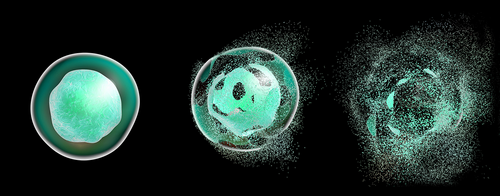Cell Lysis Buffers
Selecting the right cell lysis buffer is a critical step in many research applications across various scientific disciplines, ranging from molecular biology to cell biology and biochemistry. The choice of cell lysis buffer can significantly impact the quality and reliability of experimental results, making it a fundamental consideration for researchers. This importance stems from several key factors.

1
First, the choice of cell lysis buffer affects the efficiency of cell membrane and nuclear membrane disruption, allowing access to intracellular components. Therefore, the lysis buffer should be chosen with regard to the cellular compartment of the molecules of interest. In addition, different cell types and tissues have distinct membrane compositions and structures, necessitating specific lysis buffers tailored to their characteristics. The wrong buffer can result in incomplete cell lysis, leading to skewed or inaccurate data.
2
Secondly, the appropriate lysis buffer is crucial for maintaining the stability and integrity of the molecules of interest within the cell. For example, in nucleic acid research, the choice of lysis buffer can impact the preservation of RNA, DNA, and their modifications. In proteomics, it influences the stability of proteins and post-translational modifications. Using the wrong buffer may lead to degradation or modification of these molecules, compromising the validity of downstream analyses.
3
Lastly, the selection of a suitable cell lysis buffer is essential for controlling experimental variables. Different buffers can influence pH, ionic strength, and the presence of detergents, which can impact the structure and activity of enzymes, proteins, and other cellular components. Consistency in buffer choice is critical for ensuring reproducibility across experiments and laboratories.
Careful consideration of these key factors is essential for selecting the best cell lysis buffer.
A Comparison of BPS Bioscience Cell Lysis Buffers
| Name | NP-40 Cell Lysis Buffer | Modified NP-40 Cell Lysis Buffer | Modified RIPA Lysis Buffer | RIPA Lysis Buffer |
|---|---|---|---|---|
| Strength | Mild | Moderate Mild | Moderate Strong | Strong |
| Detergent strength and protein extraction | Extraction of cytoplasmic proteins in non-denaturing conditions | Extraction of cytoplasmic proteins in mild anionic conditions | Extraction of cytoplasmic and nuclear proteins in mild denaturing conditions. SDS-free buffer. | Extraction of cytoplasmic and nuclear proteins in denaturing conditions. Not suitable for sensitive proteins or protein complexes. |
| Recommended application | ELISA IP Pull-down Native PAGE SDS-PAGE Western blotting |
ELISA IP Pull-down Native PAGE SDS-PAGE Western blotting |
ELISA SDS-PAGE Western blotting |
SDS-PAGE Western blotting |
| Formula | 50 mM Tris HCl pH 7.4 150 mM NaCl 1 mM EDTA 1 mM EGTA 1% IGEPAL CA-630 |
50 mM Tris HCl pH 7.4 150 mM NaCl 1 mM EDTA 1 mM EGTA 1% IGEPAL CA-630 0.1% sodium deoxycholate |
50 mM Tris HCl pH 7.4 150 mM NaCl 1 mM EDTA 1 mM EGTA 0.5% Triton X-100 0.5% sodium deoxycholate |
50 mM Tris HCl pH 7.4 150 mM NaCl 1 mM EDTA 1 mM EGTA 1% Triton X-100 1% sodium deoxycholate 0.1% SDS |
| Compatible protein measurement method | BCA assay | BCA assay | BCA assay | BCA assay |
| Catalog #, Size | 82124, 100 ml | 82125, 100 ml | 82126, 100 ml | 82127, 100 ml |
Interested in trying all four buffers? Check out our: Cell Lysis Buffer Sample Kit, which includes 20 ml of each of the buffers above.
Inquiries
│Products
- NP-40 Cell Lysis Buffer
- Modified NP-40 Cell Lysis Buffer
- Modified RIPA Lysis Buffer
- RIPA Lysis Buffer
- Cell Lysis Buffer Sample Kit
- LysA™ Protease Inhibitor Cocktail Kit

